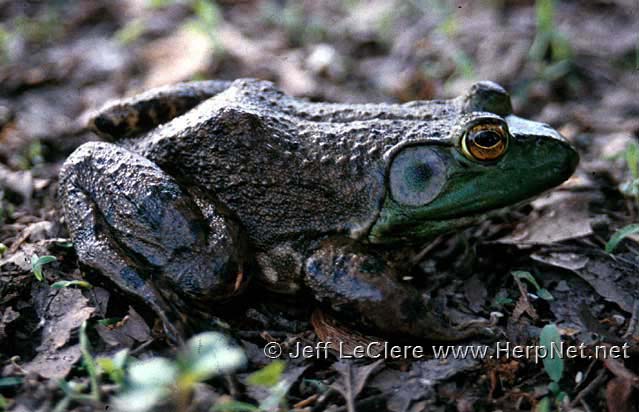American Bullfrog (Lithobates catesbeianus)
Alternate names: Rana catesbeiana
by Jeff LeClere

American bullfrogs, Lithobates catesbeianus, calling.
Status
A valid fishing license is required to possess this species for bait or food. Bullfrogs are common in Iowa.
Description
The American bullfrog (hereafter “bullfrog”) is Iowa’s largest frog species reaching 8 inches in body length and over a foot long with legs outstretched. The bullfrog’s skin color can be anywhere from light green to dark olive to nearly brown or black. The shade of color may vary in any individual at different temperatures. Typically, darkness will cause a frog to lighten up. Frogs that are cold or trying to absorb heat will be dark.

Some bullfrogs may not have a dorsal pattern, but others may be heavily reticulated with dark brown or black. There may be dark bars on the front and back legs. Ventrally, they may be white, gray, or yellowish. Some may have plain bellies, but most of them have gray or brown reticulation/networking from the sides to the center. There are markings on the undersides of the hind legs as well.
The throat is light in females and young, but some big males develop a very bright yellow throat. Further, and more reliable sexual dimorphism is displayed by the size of the tympanum (the tympanum is the circular disk just behind the eyes; this is the eardrum). Males have tympana larger than their eyes. The tympana of females are the same size or slightly smaller then their eyes. Bullfrogs do not have dorsolateral ridges. The hind foot is extensively webbed except for the last digit on the fourth toe. The size of the adult bullfrog and the absence of dorsolateral ridges distinguish it from the very similar green frog.
Subspecies
There are no subspecies of the American bullfrog recognized.
Range
The natural historic range of the bullfrog in Iowa was along the Mississippi River in the eastern part of the state and in southern Iowa. They are now found statewide due to introduced populations that began in the 1940s for frog legs (Bailey, 1944).

Habitat
Bullfrogs require permanent bodies of water in which to breed and live. Lakes, ponds, oxbows, Mississippi River backwaters, and sometimes slow parts of large rivers are favorite haunts.
Habits
Bullfrogs are active in April, but they do not breed until June through July. The breeding calls of males are often described as a deep “jug-o-rum”. A deep “rum” seems more appropriate. The call is a “rum” given once every second and usually repeated consecutively five or six times. Sometimes, the last few calls stutter. Even large bullfrog choruses do not have many frogs, and the calls rarely overlap as extensively as in some other Iowa frogs. This is partly because a male bullfrog will establish and defend a large nine foot radius territory. I have seen male bullfrogs wrestling. I remember seeing several bouts in a single sunny afternoon in Van Buren County. A male would enter another male’s territory. The defending male would swim out to meet the intruder in deeper water. The two would grasp each other with their forelimbs and wrestle. This causes much splashing. Finally one frog would overpower and win the match, while the loser would retreat out of the territory.

Female bullfrogs lay 10,000 to 20,000 eggs in large masses. The tadpoles take two years to transform. They are the largest tadpoles found in Iowa. They are green with dark spotting on the body and tail. The underside is white or yellow. Bullfrogs are active day and night, although movement along water courses usually occurs at night and overland movements often take place on rainy nights. Otherwise, adults usually do not move far, staying in or close to their home pond. Some young bullfrogs may move considerable distances to find new homes.
When approached, bullfrogs may slip into the water and swim away silently, but more often they make a fantastic leap. They usually emit a loud high-pitched “meap!” and make several jumps over the surface of the water before diving and remaining submerged for several minutes. If picked up, rare individuals will scream with an open mouth. Adults and tadpoles alike overwinter at the bottom of their home lake or pond. The adults are inactive at this time, but the tadpoles may swim and even feed under the ice. When introduced to areas outside their historically native range, bullfrogs can be destructive to the new environment displacing and/or eating anything smaller than themselves, including other frog species. They may also be carriers of the deadly chytrid fungus; spreading the disease to other amphibians even though they may not be affected themselves.
Food
Bullfrogs are voracious and eat anything they can fit into their mouths. Aside from smaller normal prey, they have been known to eat other frogs and toads, tadpoles, fish, small snakes, and turtles, even small birds and rodents. They are also detrimental to other frog populations when they are introduced into an area that did not formerly have bullfrogs. Anglers and froggers use this large appetite to their advantage. A hook baited with almost anything (red plastic worms or red cloth works well) is dangled in front of them and they are caught like fish (note: a valid fishing license is required to take frogs in Iowa).



